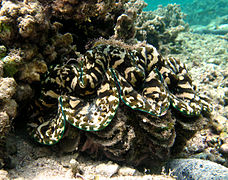Tridacninae
| Tridacninae | |
|---|---|

| |
| Two "giant clams", from the two current genera : Hippopus hippopus & Tridacna squamosa. | |
| Scientific classification | |
| Domain: | Eukaryota |
| Kingdom: | Animalia |
| Phylum: | Mollusca |
| Class: | Bivalvia |
| Order: | Cardiida |
| Family: | Cardiidae |
| Subfamily: | Tridacninae Lamarck, 1819 |
| Genera | |
|
See text | |
Tridacnidae, common name the giant clams, is a taxonomic subfamily of very large saltwater clams, marine bivalve molluscs in the family Cardiidae, the cockles.
Description
[edit]This subfamily contains the largest living bivalve species, including Tridacna gigas, the giant clam. They have heavy shells, fluted with 4–6 folds. The mantle is usually brightly colored. They inhabit coral reefs in warm seas in the Indo-Pacific region. Most of these clams live in symbiosis with photosynthetic dinoflagellates (zooxanthellae), a type of photosymbiosis.
Systematics
[edit]Sometimes the giant clams are still treated as a separate family Tridacnidae,[1] but modern phylogenetic analyses included them in the family Cardiidae as a subfamily.[2][3] Two recent genera and eight species are known:
Recent genetic evidence has shown them to be monophyletic sister taxa.[4]
-
Live Hippopus hippopus (Vanuatu)
-
Live Tridacna squamosa (la Réunion)
-
Hippopus hippopus shells
-
Giant clam (Tridacna gigas) shell
Human relevance
[edit]In some areas, such as the Philippines, smaller members of the subfamily are farmed to supply the marine aquarium trade and food trade towards east Asia. All species in the Tridacninae family are protected under CITES Appendix II meaning international trade requires CITES permits to be granted.[5]
Evolutionary history
[edit]Tridacinae originated in Western Europe during the Eocene, expanding eastwards towards Arabia by the Oligocene, and becoming established in its modern distribution in the Indo-Pacific during the Pliocene-Pleistocene.[6]
References
[edit]- ^ WoRMS. (2009). Tridacnidae. Accessed through the World Register of Marine Species at http://www.marinespecies.org/aphia.php?p=taxdetails&id=196336 on 2009-01-10.
- ^ Schneider,J. Phylogeny of cardiid bivalves (cockles and giant clams): revision of the Cardiinae and the importance of fossils in explaining disjunct biogeographical distributions. Zoological Journal of the Linnean Society, 2002,136, 321–369
- ^ Keys,J.L., Helay,J.M. Relevance of Sperm Ultrastructure to the Classification of Giant Clams (Mollusca, Cardioidea, Cardiidae, Tridacnidae)(in: Harper et al., (Eds) The Evolutionary Biology of the Bivalvia, Geological Society Special Publication No 177, 2000)
- ^ Schneider, J.A.,and O´Foighil, D. Phylogeny of Giant Clams (Cardiidae: Tridacnidae) Based on Partial Mitochondrial 16S rDNA Gene Sequences. Molecular Phylogenetics and Evolution Vol. 13, No. 1, October, pp. 59–66, 1999
- ^ "Checklist of CITES species".
- ^ Harzhauser, Mathias; Kroh, Andreas; Mandic, Oleg; Piller, Werner E.; Göhlich, Ursula; Reuter, Markus; Berning, Björn (December 2007). "Biogeographic responses to geodynamics: A key study all around the Oligo–Miocene Tethyan Seaway". Zoologischer Anzeiger - A Journal of Comparative Zoology. 246 (4): 241–256. doi:10.1016/j.jcz.2007.05.001. ISSN 0044-5231.
External links
[edit]





